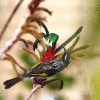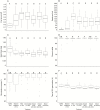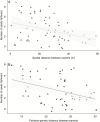Near-neighbour optimal outcrossing in the bird-pollinated Anigozanthos manglesii
- PMID: 31115446
- PMCID: PMC6798840
- DOI: 10.1093/aob/mcz091
Near-neighbour optimal outcrossing in the bird-pollinated Anigozanthos manglesii
Abstract
Background and aims: In plants, the spatial and genetic distance between mates can influence reproductive success and offspring fitness. Negative fitness consequences associated with the extremes of inbreeding and outbreeding suggest that there will be an intermediate optimal outcrossing distance (OOD), the scale and drivers of which remain poorly understood. In the bird-pollinated Anigozanthos manglesii (Haemodoraceae) we tested (1) for the presence of within-population OOD, (2) over what scale it occurs, and (3) for OOD under biologically realistic scenarios of multi-donor deposition associated with pollination by nectar-feeding birds.
Methods: We measured the impact of mate distance (spatial and genetic) on seed set, fruit size, seed mass, seed viability and germination success following hand pollination from (1) single donors across 0 m (self), <1 m, 1-3 m, 7-15 m and 50 m, and (2) a mix of eight donors. Microsatellite loci were used to quantify spatial genetic structure and test for the presence of an OOD by paternity assignment after multi-donor deposition.
Key results: Inter-mate distance had a significant impact on single-donor reproductive success, with selfed and nearest-neighbour (<1 m) pollination resulting in only ~50 seeds per fruit, lower overall germination success and slower germination. Seed set was greatest for inter-mate distance of 1-3 m (148 seeds per fruit), thereafter plateauing at ~100 seeds per fruit. Lower seed set following nearest-neighbour mating was associated with significant spatial genetic autocorrelation at this scale. Paternal success following pollination with multiple sires showed a significantly negative association with increasing distance between mates.
Conclusions: Collectively, single- and multi-donor pollinations indicated evidence for a near-neighbour OOD within A. manglesii. A survey of the literature suggests that within-population OOD may be more characteristic of plants pollinated by birds than those pollinated by insects.
Keywords: Anigozanthos manglesii; OCBIL; Optimal outcrossing; bird pollination; fitness; hand pollination; inbreeding.
© The Author(s) 2019. Published by Oxford University Press on behalf of the Annals of Botany Company. All rights reserved. For permissions, please e-mail: journals.permissions@oup.com.
Figures





References
-
- Aizen MA, Harder LD. 2007. Expanding the limits of the pollen-limitation concept: effects of pollen quantity and quality. Ecology 88: 271–281. - PubMed
-
- Ayre DJ, O’Brien E. 2013. Does provenance matter? Fitness is not determined by genetic distance or the scale of pollen dispersal in Grevillea sphacelata (Proteaceae). Botanical Journal of the Linnean Society 173: 290–302.
-
- Baskin JM, Baskin CC. 2015. Inbreeding depression and the cost of inbreeding on seed germination. Seed Science Research 25: 355–385.
-
- Bateson P. 1978. Sexual imprinting and optimal outbreeding. Nature 273: 659–660. - PubMed
Publication types
MeSH terms
LinkOut - more resources
Full Text Sources

